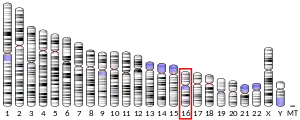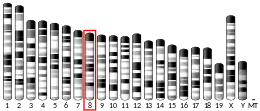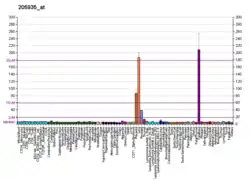FOXF1
Forkhead box protein F1 is a protein that in humans is encoded by the FOXF1 gene.[5][6][7]
Function
This gene belongs to the forkhead family of transcription factors which is characterized by a distinct forkhead domain. The specific function of this gene has not yet been determined; however, it may play a role in the regulation of pulmonary genes as well as embryonic development.[7]
References
- GRCh38: Ensembl release 89: ENSG00000103241 - Ensembl, May 2017
- GRCm38: Ensembl release 89: ENSMUSG00000042812 - Ensembl, May 2017
- "Human PubMed Reference:". National Center for Biotechnology Information, U.S. National Library of Medicine.
- "Mouse PubMed Reference:". National Center for Biotechnology Information, U.S. National Library of Medicine.
- Larsson C, Hellqvist M, Pierrou S, White I, Enerbäck S, Carlsson P (Dec 1995). "Chromosomal localization of six human forkhead genes, freac-1 (FKHL5), -3 (FKHL7), -4 (FKHL8), -5 (FKHL9), -6 (FKHL10), and -8 (FKHL12)". Genomics. 30 (3): 464–9. doi:10.1006/geno.1995.1266. PMID 8825632.
- Pierrou S, Hellqvist M, Samuelsson L, Enerbäck S, Carlsson P (Oct 1994). "Cloning and characterization of seven human forkhead proteins: binding site specificity and DNA bending". The EMBO Journal. 13 (20): 5002–12. doi:10.1002/j.1460-2075.1994.tb06827.x. PMC 395442. PMID 7957066.
- "Entrez Gene: FOXF1 forkhead box F1".
Further reading
- Murphy DB, Wiese S, Burfeind P, Schmundt D, Mattei MG, Schulz-Schaeffer W, Thies U (Jun 1994). "Human brain factor 1, a new member of the fork head gene family". Genomics. 21 (3): 551–7. doi:10.1006/geno.1994.1313. PMID 7959731.
- Hellqvist M, Mahlapuu M, Samuelsson L, Enerbäck S, Carlsson P (Feb 1996). "Differential activation of lung-specific genes by two forkhead proteins, FREAC-1 and FREAC-2". The Journal of Biological Chemistry. 271 (8): 4482–90. doi:10.1074/jbc.271.8.4482. PMID 8626802.
- Hellqvist M, Mahlapuu M, Blixt A, Enerbäck S, Carlsson P (Sep 1998). "The human forkhead protein FREAC-2 contains two functionally redundant activation domains and interacts with TBP and TFIIB". The Journal of Biological Chemistry. 273 (36): 23335–43. doi:10.1074/jbc.273.36.23335. PMID 9722567.
- Mahlapuu M, Pelto-Huikko M, Aitola M, Enerbäck S, Carlsson P (Oct 1998). "FREAC-1 contains a cell-type-specific transcriptional activation domain and is expressed in epithelial-mesenchymal interfaces". Developmental Biology. 202 (2): 183–95. doi:10.1006/dbio.1998.9010. PMID 9769171.
- Coon DR, Roberts DJ, Loscertales M, Kradin R (Apr 2006). "Differential epithelial expression of SHH and FOXF1 in usual and nonspecific interstitial pneumonia". Experimental and Molecular Pathology. 80 (2): 119–23. doi:10.1016/j.yexmp.2005.12.003. PMID 16448649.
- Lomenick JP, Hubert MA, Handwerger S (Nov 2006). "Transcription factor FOXF1 regulates growth hormone variant gene expression". American Journal of Physiology. Endocrinology and Metabolism. 291 (5): E947-51. doi:10.1152/ajpendo.00128.2006. PMID 16772323.
External links
- FOXF1+protein,+human at the US National Library of Medicine Medical Subject Headings (MeSH)
This article incorporates text from the United States National Library of Medicine, which is in the public domain.
This article is issued from Wikipedia. The text is licensed under Creative Commons - Attribution - Sharealike. Additional terms may apply for the media files.





